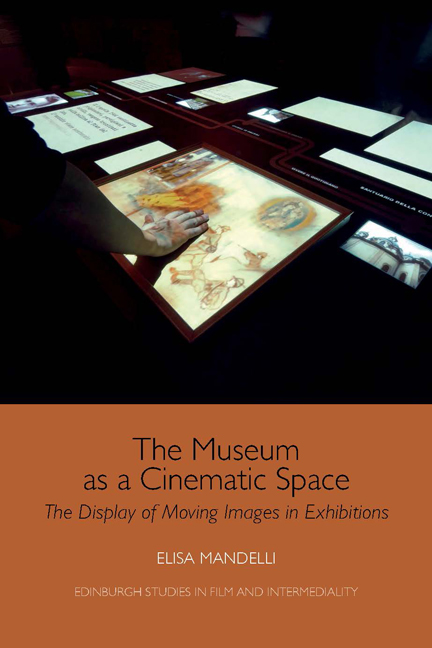Book contents
- Frontmatter
- Contents
- List of Figures
- Acknowledgements
- Preface
- Introduction
- Part I Between History and Modernity: Films in Exhibitions in the Twentieth Century
- Part II The Museum as a Cinematic Space: Museums and Moving Images in the Twenty-first Century
- 5 From the Museum Experience to the Museum as an Experience
- 6 Audio-visuals in Exhibitions
- 7 The Museum and its Spectres
- 8 A Walk through Images
- 9 New Interpretations of the Movie Theatre
- 10 Touching Images
- Conclusions
- Bibliography
- Index
8 - A Walk through Images
from Part II - The Museum as a Cinematic Space: Museums and Moving Images in the Twenty-first Century
Published online by Cambridge University Press: 24 October 2019
- Frontmatter
- Contents
- List of Figures
- Acknowledgements
- Preface
- Introduction
- Part I Between History and Modernity: Films in Exhibitions in the Twentieth Century
- Part II The Museum as a Cinematic Space: Museums and Moving Images in the Twenty-first Century
- 5 From the Museum Experience to the Museum as an Experience
- 6 Audio-visuals in Exhibitions
- 7 The Museum and its Spectres
- 8 A Walk through Images
- 9 New Interpretations of the Movie Theatre
- 10 Touching Images
- Conclusions
- Bibliography
- Index
Summary
The concern for the visitors’ itinerary inside the museum emerged during the nineteenth and twentieth centuries. Back then, according to Tony Bennett, museum institutions (as well as fairs and universal expositions) became places for ‘organised walking’ where the visitors’ behaviour and the transmission of knowledge were regulated by more or less pre-determined itineraries, as was the (more or less implicit) imposition of a certain ideology and power relationships. In contemporary museography, where the connection between objects and narrative has become more fluid and open to different interpretations, the movements of the visitors remain nonetheless central for their capacity to activate, follow, and re-design meaningful itineraries.
The link between the museum path and the cinematic dispositif could be addressed in light of the broader question of the relationship between moving images and architecture. It was during the 1920s and 1930s that a strong connection between film and architectonic space came into place, both in theory and practice. Sergei Eisenstein's well-known essay ‘Montage and Architecture’ constitutes a pivotal attempt to ground theoretically the intersections between cinema and architecture. Starting from Auguste Choisy's description of the positioning of buildings on the Acropolis of Athens, as related to the variable point of view of a walking observer, Eisenstein postulates a link between montage and the composition of an architectural ensemble, from the perspective of a moving spectator. Eisenstein considered sequentiality and montage as the two essential conditions of film as a medium and used them as a grid for the appreciation of other arts. His notion of ‘cinematism’, a series of structural proprieties that are independent from any medium, allowed him to underline the temporal dimension inscribed in architecture as well as in painting.
Moreover, during the 1920s, as Olivier Lugon has explained, exponents of the avant-garde also established a strong link between the cinematic dispositif and the exhibition. By experimenting with innovative ways of arranging objects, they conceived a series of displays that were deeply influenced by the dynamism and mobility of cinema. As Lugon writes,
what designers envied most about film was the possibility of controlling a sequence of images, of imposing on the visitor a planned progression of pictures, impressions and information. Hence the following challenge: how to extend this principle of unfolding to a three-dimensional space …?
- Type
- Chapter
- Information
- The Museum as a Cinematic SpaceThe Display of Moving Images in Exhibitions, pp. 105 - 114Publisher: Edinburgh University PressPrint publication year: 2019



